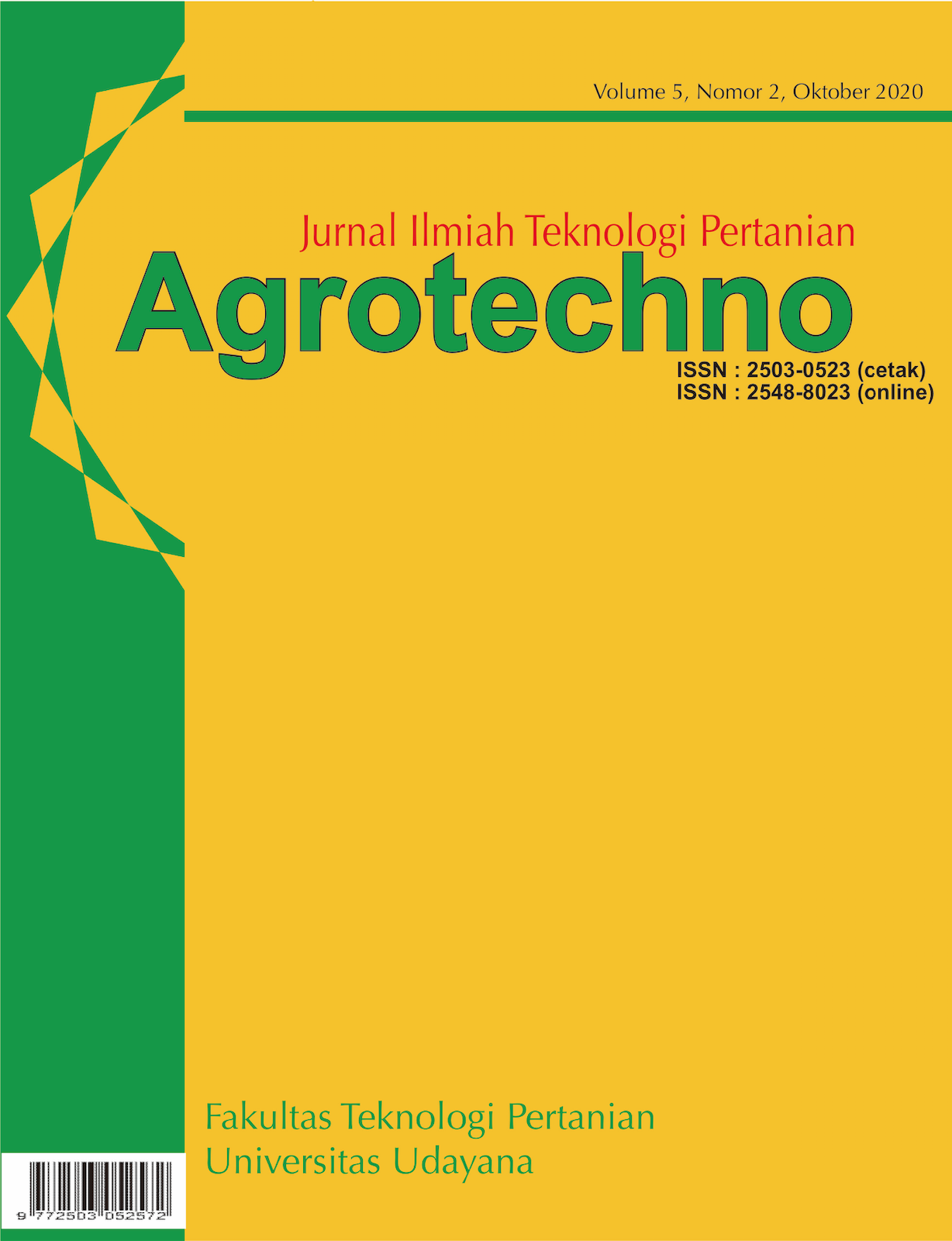Karakteristik Komposit Bioplastik Dalam Variasi Rasio Pati Umbi Talas (Xanthosoma sagittifolium)-Kitosan
Abstract
This research aims to know the effect of variations in the ratio of taro-chitosan tuber starch to the characteristics of bioplastic composites and determine the ratio of taro-chitosan tuber starch that produces the best bioplastic composites. This research uses a Factorial Randomized Block design with taro-chitosan tuber starch ratio variation factor in five level (40: 60%, 35: 65%, 30: 70%, 25: 75% and 20: 80%). The treatments which grouped into 3 based on the time of making bioplastics, so there are 15 experimental units. The observed variables which tensile strength, elongation at break, modulus young, swelling development, biodegradation and FTIR test. The obtained data were analyzed for diversity and continued with the Honestly Significant Difference test. The results showed that the variation of the taro-chitosan tuber starch ratio significantly affected the tensile strength, elongation at break, modulus young, and swelling development but did not significantly affected the biodegradation of the bioplastic composites of taro-chitosan tuber starch. Variation of taro-chitosan tuber starch ratio 35: 65% produces the best bioplastic composite characteristics with tensile strength values 3.15 MPa, elongation at break 21.33%, modulus young of 14.87 MPa, swelling development test 29.69% and biodagradation ability for 13 days. FTIR analysis results show the presence of hydroxyl (O-H) alcoholic groups, (O-H) Carboxylic acid, (C = O) esters, (C - H) alkana, (C=C) alkena , and hydrocarbons - (CH2) n.
Downloads
References
Arini, D Syahrul, U dan Kasman, 2017. Pembuatan dan Pengujian Sifat Mekanik Plastik Biodegradable Berbasis Tepung Biji Durian . Journal of Science and Technology, 6(3):276-283.
Averous, L. 2004. Biodegradable multiphase systems based on plasticizer starch. J Macromol Sci. 12(2):123-130.
Darni,Y dan H. Utami. 2010. Studi pembuatan dan karakteristik sifat mekanik dan hidrofobisitas bioplastik dari pati sorgum. Jurnal Rekayasa Kimia dan Lingkungan, 7(4):88-93.
Eka, A.R. dan Suyanto. 2015. Pengaruh konsentrasi karagenan terhadap sifat fisik mekanik edible film dari pati bonggol pisang dan karagenan dengan plasticizier gliserol sebagai bahan pengemas makanan. Jurnal Kimia. 4(3):34-40.
Fajri, G., Hasan dan M, Zulfadli. 2017. Pembuatan dan Karakterisasi Bioplastik dari Kitosan, Pati Talas (Colocasia esculenta) dan Minyak Jarak. Program Studi FKIP, Universitas Syiah Kuala, Darussalam Banda Aceh.
Gibson, R. F. 1994. Principles of Composite Material Mechanism.New York, McGraw-Hill.Inc.
Harnist, R. dan Y. Darni. 2011. Penentuan Kondisi Optimum Konsentrasi Plasticizer pada Sintesa Plastik Biodegradable Berbahan Dasar Pati Sorgum. Seminar Nasional Sains dan Teknologi-II. Universitas Lampung, Lampung.
Hartatik, Y. D., L. Nuriyah dan Iswarin. 2014. Pengaruh Komposisi Kitosan Terhadap Sifat Mekanik Dan Biodegradable Bioplastik. Jurusan Fisika FMIPA, Universitas Brawijaya, Malang.
Jabbar, F.U., 2017. Pengaruh penambahan kitosan terhadap karakteristik bioplastik dari pati kulit kentang (solanum tuberosum. L. Skripsi. Fakultas Sains Dan Teknologi. Uin Alauddin Makassar.
Pavia, D. L., Gary M. L., George S. K dan Randall G. E. 2008. Introduction to Spectroscopy, Fourth Edition. United States of America. Book Cole.
Pranamuda. 2003. Pengembangan Bahan Film Plastik Berbahan Baku Pati Tropis.Badan Pengkajian dan Penerapan Teknologi. Jakarta.
Rahmawati, W., Y.A. Kusumastuti dan N.Aryanti. 2012. Karakteristik pati talas (Colocasia esculenta (L) Schott) sebagai alternatif sumber pati industri di Indonesia. Jurnal Teknologi Kimia dan Industri. 1(1): 347-351.
Rodriguez, M., O. Javier, Z. Khalid and I. M. Juan. 2006. Combined Effect of Plasticizers and Surfactants on the Physical Properties of Starch-Based Edible Film. Food Research International. 39(1) : 646-840.
Puspita, T. dan Sanjaya, I.G. 2013. Pengaruh Penambahan Kitosan dan Plasticizer Gliserol Pada Karakteristik Plastik Biodegradable Dari Pati Limbah Kulit Singkong. Skripsi Teknik Industri, Institut Teknologi Sepuluh November. Surabaya.
Setiani, W., T. Sudiarti dan L. Rahmidar. 2013. Preparasi dan karakterisasi edible film dari poliblend pati sukun-kitosan. Valensi. 3(2): 100-109.
Yulianti dan Ginting.“Perbedaan Karakteristik Fisik Edible Film dari Umbi-Umbian yang Dibuat dengan Penambahan Plasticizer”. Penelitian Pertanian Tanaman Pangan 31 No. 2, 2012.










